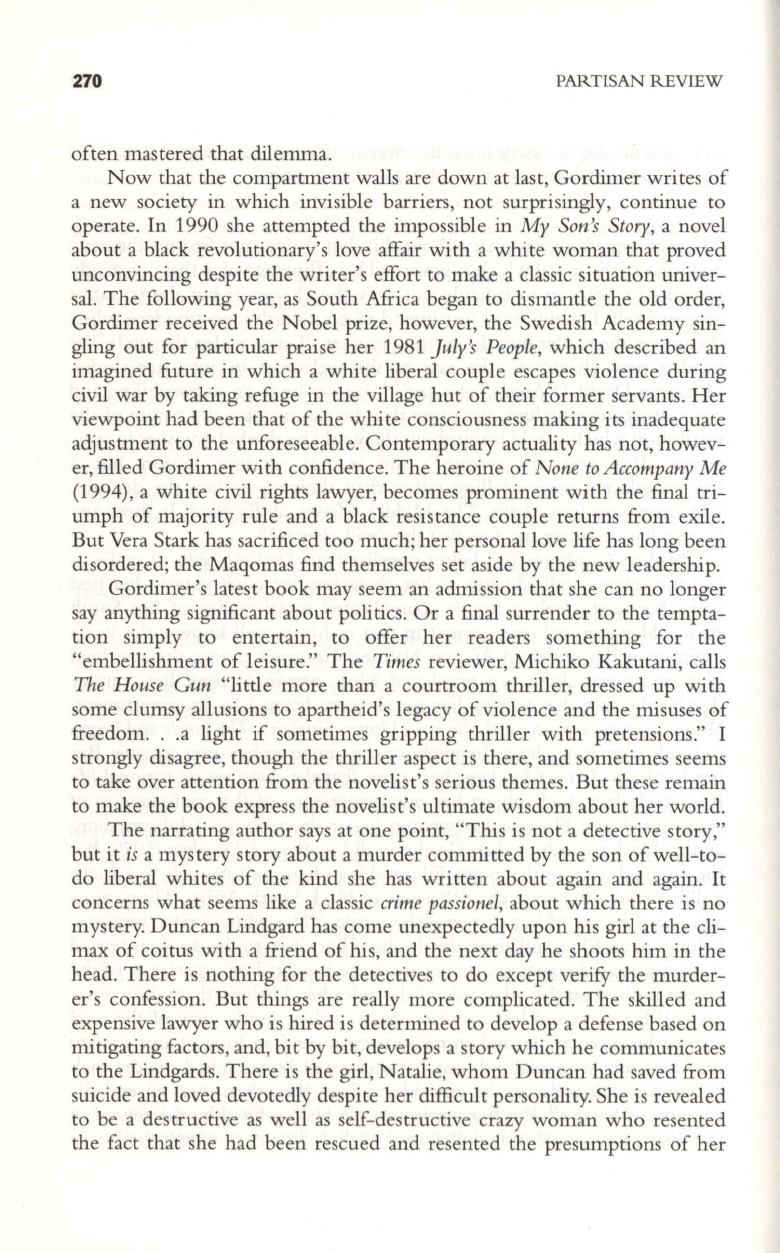
270
PARTISAN REVIEW
often mastered that dilemma.
Now that the compartment walls are down at last, Gordimer writes of
a new society in which invisible barriers, not surprisingly, continue to
operate. In 1990 she attempted the impossible in
My
Son's Story,
a novel
about a black revolutionary's love affair with a white woman that proved
unconvincing despite the writer's effort to make a classic situation univer–
sal. The following year, as South Africa began to dismantle the old order,
Gordimer received the Nobel prize, however, the Swedish Academy sin–
gling out for particular praise her 1981
July's People,
which described an
imagined future in which a white liberal couple escapes violence during
civil war by taking refuge in the village hut of their former servants. Her
viewpoint had been that of the white consciousness making its inadequate
adjustment to the unforeseeable. Contemporary actuality has not, howev–
er, filled Gordimer with confidence. The heroine of
None to Accompany
Me
(1994), a white civil rights lawyer, becomes prominent with the final tri–
umph of majority rule and a black resistance couple returns from exile.
But Vera Stark has sacrificed too much; her personal love life has long been
disordered; the Maqomas find themselves set aside by the new leadership.
Gordimer's latest book may seem an admission that she can no longer
say anything significant about politics. Or a final surrender to the tempta–
tion simply to entertain, to offer her readers something for the
"embellishment of leisure." The
Times
reviewer, Michiko Kakutani, calls
The House Gun
"little more than a courtroom thriller, dressed up with
some clumsy allusions to apartheid's legacy of violence and the misuses of
freedom...a light if sometimes gripping thriller with pretensions." I
strongly disagree, though the thriller aspect is there, and sometimes seems
to take over attention from the novelist's serious themes. But these remain
to make the book express the novelist's ultimate wisdom about her world.
The narrating author says at one point, "This is not a detective story,"
but it
is
a mystery story about a murder committed by the son ofwell-to–
do liberal whites of the kind she has written about again and again. It
concerns what seems like a classic
crime passionel,
about which there is no
mystery. Duncan Lindgard has come unexpectedly upon his girl at the cli–
max of coitus with a friend of his, and the next day he shoots him in the
head. There is nothing for the detectives to do except verify the murder–
er's confession. But things are really more complicated. The skilled and
expensive lawyer who is hired is determined to develop a defense based on
mitigating factors, and, bit by bit, develops a story which he communicates
to the Lindgards. There is the girl, Natalie, whom Duncan had saved from
suicide and loved devotedly despite her difficult personality. She is revealed
to be a destructive as well as self-destructive crazy woman who resented
the fact that she had been rescued and resented the presumptions of her


